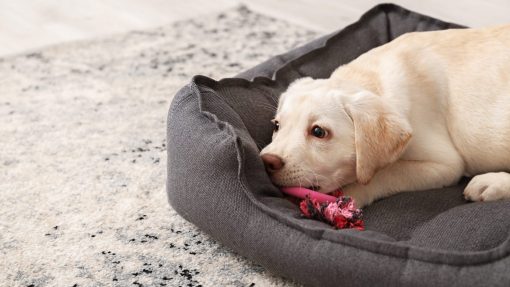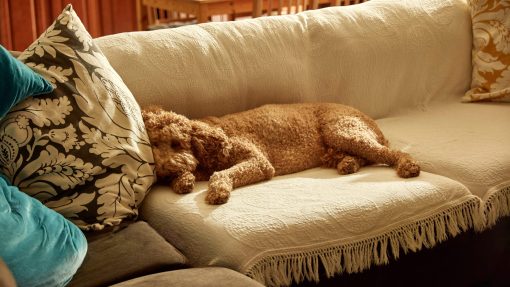The first month with your new puppy is a joyful yet crucial time that sets the tone for your life together. It’s when trust is built, routines are formed, and your puppy begins to understand their place in the family. From feeding schedules to socialization, every small step plays a big role in shaping your pup’s behavior and well-being. Whether you are a first-time dog parent or adding another furry friend to your home, these 10 essential tips will help you make the most of this important first month—ensuring a smooth, happy start for both you and your puppy.
What to Know in Your Puppy’s First Month
Bringing a puppy into your home is a joyful experience, but it also requires careful planning. Before welcoming a new furry friend, it’s important to prepare your environment, lifestyle, and mindset. These 10 key factors will help ensure a smooth start for both you and your puppy.
1. Time Commitment
Puppies need consistent attention, training, and socialization. Ensure your daily schedule allows enough time for feeding, play, walks, and supervision.
2. Financial Responsibility
Owning a puppy involves ongoing expenses such as food, grooming, vet visits, vaccinations, toys, and unexpected medical bills. Be prepared for the long-term financial commitment.
3. Breed Research
Different breeds have unique traits, energy levels, and care needs. Choose a breed that matches your lifestyle, living space, and experience level.
4. Home Preparation
Puppy-proof your home by removing hazards like electrical cords, harmful plants, and breakable items. Create a safe, designated area for rest and play.
5. Supplies Checklist
Gather essentials such as a collar, leash, crate, bedding, food and water bowls, grooming tools, and safe chew toys before your puppy arrives.
6. Vet and Healthcare Planning
Identify a trusted veterinarian and learn about vaccination schedules, deworming, flea/tick prevention, and microchipping. Schedule an initial health check-up early.
7. Training Readiness
Be ready to teach basic commands, potty habits, and appropriate behavior from day one. Consistent, positive training builds a strong foundation.
8. Family Agreement
Make sure all household members are on board with the decision and understand their roles in caring for the puppy. Consistency across family members is essential.
9. Lifestyle Adjustments
Expect changes to your daily routine, travel plans, and social life. Puppies require structure and can’t be left alone for extended periods.
10. Long-Term Commitment
A puppy grows into a dog that will be part of your life for many years. Consider your long-term plans, living arrangements, and ability to provide lifelong care.

How Prepare Your Home Before the Puppy Arrives
A well-prepared home creates a safe, welcoming space for your puppy’s first days. From securing rooms to organizing essentials, taking a few simple steps in advance can help your puppy settle in smoothly and avoid early mishaps.
1. Puppy-Proof Every Room
Puppies are naturally curious and love to explore with their mouths. Remove small objects, secure loose wires, keep household cleaners and sharp items out of reach, and install baby gates if needed. Keep shoes, remote controls, and anything chewable out of sight.
2. Set Up a Safe Sleeping Area
Choose a quiet, cozy spot where your puppy can rest undisturbed. A crate or puppy bed works well and helps establish a routine. Make it comfortable with soft blankets, but avoid pillows or toys with small parts that could be swallowed.
3. Create a Feeding Station
Designate a specific area in the kitchen or corner of a room for feeding. Use sturdy bowls for food and water to prevent spills, and place them on a mat to keep the area clean. This helps your puppy learn where to eat and drink consistently.
4. Stock Up on Essentials
Buy everything your puppy needs before arrival. This includes food, treats, a collar with ID tag, a leash, poop bags, grooming supplies, and teething toys. Having these ready reduces stress and allows you to focus on bonding when your puppy comes home.
5. Plan for Potty Training
Decide where you want your puppy to go potty—indoors on puppy pads or outside. If outdoors, choose a safe, accessible area. Have cleaning supplies ready for accidents and be consistent in guiding your puppy to the right spot from day one.
6. Remove Toxic Plants
Many common houseplants like aloe vera, lilies, and pothos are toxic to dogs if ingested. Research which plants are harmful and remove or relocate them out of reach. Replace them with pet-safe options like spider plants or areca palms.
7. Store Food and Chemicals Securely
Keep human food, medications, and cleaning supplies in cabinets with secure latches or on high shelves. Puppies can be surprisingly clever at accessing cabinets and may chew through packaging.
8. Designate a Play Area
Choose a safe space indoors where your puppy can play freely. Use a playpen or gated area to create boundaries and keep them away from valuable furniture or décor. Fill it with safe toys and rotate them to keep things interesting.
9. Secure Outdoor Spaces
If you have a yard, make sure fences are secure and there are no gaps where a small puppy could escape. Remove any sharp tools, poisonous plants, or dangerous chemicals like fertilizers from reach.
10. Introduce Household Sounds Early
Puppies can be startled by loud or unfamiliar noises. Gradually introduce everyday sounds like the vacuum cleaner, doorbell, and washing machine so they become comfortable with normal household activities.

Explore Tips for a Happy First Month with Your New Puppy
A puppy’s arrival marks the beginning of a fun and rewarding journey. The early days play a key role in shaping your pup’s behavior and emotional well-being. By following a few simple but effective tips, you can help your puppy feel secure, loved, and ready to thrive in their new home.
Here are 10 practical tips to ensure a smooth and happy start to your journey together.
1. Stick to a Consistent Routine
Feed, walk, and play with your puppy at the same times every day. A predictable schedule helps reduce anxiety and teaches your puppy what to expect. Regularity builds trust and supports healthy habits like potty training and good sleep patterns.
2. Introduce a Name Early
Start using your puppy’s name from day one in a cheerful, calm voice. Repeat it during play, feeding, and cuddles so they quickly associate their name with positive attention. This lays the foundation for strong communication and training.
3. Offer Social Exposure Gradually
Gently introduce your puppy to new people, pets, places, and household noises. Keep early experiences short and positive to prevent overwhelm. Controlled exposure helps your pup grow into a confident, well-adjusted adult dog.
4. Keep Training Sessions Short
Young puppies have short attention spans. Stick to 5- to 10-minute sessions using clear commands, praise, and small treats. Multiple short sessions a day are more effective than long ones and keep learning fun and stress-free.
5. Monitor Health Signs Closely
Pay attention to your puppy’s appetite, energy levels, stool, and behavior. Any sudden changes may signal a problem. It’s better to contact your vet early than wait—early intervention can prevent bigger health issues.
6. Handle Gently But Regularly
During quiet times, gently touch your puppy’s paws, ears, and mouth. Make it a pleasant experience by speaking softly or offering treats. This helps them get used to being handled during grooming and vet visits later on.
7. Encourage Calm Alone Time
Help your puppy feel safe being alone by setting up a cozy crate or playpen and leaving them for short, calm periods. Gradually increase the time. This teaches independence and helps prevent future separation anxiety.
8. Keep Visitors Calm and Controlled
When guests arrive, ask them to stay calm and let the puppy approach at their own pace. Avoid loud voices or fast movements. Controlled introductions build trust and prevent fear or aggression.

9. Capture Good Moments
Document your puppy’s firsts—like learning to sit or sleeping through the night. Take photos, write little notes, or keep a progress journal. These memories are special and will remind you how far you’ve come together.
10. Be Patient and Stay Positive
Puppies will make mistakes—it’s part of learning. Use gentle corrections, stay consistent with rules, and reward good behavior. A patient, positive attitude creates a loving environment where your puppy can thrive.
Conclusion
The first month with your new puppy is a special time filled with learning, bonding, and joyful moments. By following these essential tips—establishing routines, starting training early, and offering love and patience—you’ll help your puppy feel safe, happy, and confident in their new home. Remember, every small effort you make now lays the foundation for a lifetime of companionship and trust. Enjoy the journey and cherish every wagging-tail moment!
FAQ
What is the hardest month with a puppy?
The hardest month is usually around 3 to 4 months old, when teething, biting, and testing boundaries peak. Puppies need extra patience and consistent training during this time.
Where should a puppy sleep on its first night?
A puppy should sleep in a crate or small enclosed space near your bed to help them feel safe and secure. This also helps with bonding and early potty training.
At what age are puppies the naughtiest?
Puppies are often the naughtiest between 4 and 6 months old, when they become more confident, energetic, and curious, often testing boundaries and chewing more due to teething.
Read Use Play as a Reward in Dog Training: 10 Effective Ways

